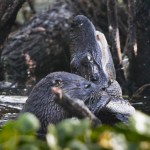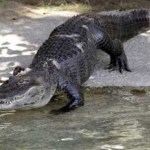alligator
...in alligators at least.
Image of alligator eggs and hatchling from National Park Service.
Researchers from the University of Manchester, University of North Texas - Denton, and the Rockefeller Wildlife Refuge - Grand Chenier, Louisiana teamed up to explore the effects of exposure to low oxygen on embryonic American alligators (Alligator mississippiensis). Alligator eggs are often laid in nests where oxygen concentrations can reportedly vary between 11-20% (21% is normal atmospheric levels). This is really important as issues related to…
I came across this neat video summarizing a study that found some birds build nests near alligators to protect themselves from other predators. But the protection is not without a price.
An river otter was captured on camera taking on an juvenile alligator...and winning. The battle took place at the Lake Woodruff National Wildlife Refuge in Florida in 2011. More images can be seen on their Facebook page where the images were recently posted, impressive! According to National Geographic, the normal diet of a river otter consists of birds, small rodents, frogs, turtles, crabs, and fish. Let's just add juvenile alligators to the list now.
Photo from U.S. FISH AND WILDLIFE SERVICE/FACEBOOK
Perhaps equally impressive is this olive python that was seen…
Today's symposia included a session on "Integrative Cardiovascular and Respiratory Physiology of Non-model Organisms" as well as the August Krogh Distinguished Lecture.
This year's Krogh lecture was given by Dr. Stan Lindstedt from Northern Arizona University. Dr. Lindstedt is arguably best known for publishing work showing that the metabolic rate of an animal is negatively correlated with body mass. In other words, smaller animals have a higher metabolic rate than larger animals. Knowing that relationship could have saved Tusko the elephant from a whopping dose of LSD (1962, prior to the…
I know Darren posted about this last year, but it is just too cool not to share again:
For more on the fruit-eating habits of crocodylians, see Darren's post on the subject here.
Figure 1: Reggie the Alligator, in 2007. (source)
Reggie is getting a girlfriend.
Reggie the Alligator has quite a long history. He was illegally raised in captivity near Long Beach, CA by two men (who were later arrested) who were involved in the illegal trade of exotic animals, but then was released into a lake in August 2005.
According to wikipedia:
City officials immediately set efforts in motion to apprehend him. The entire 53-acre lake was cordoned off and several professional "gator wranglers" were hired. But despite a nearly three month-long effort, Reggie managed to elude capture…
From the BBC:
Wildlife officials in Australia are investigating how an alligator native to North America was found wandering around a campsite in New South Wales.
Campers at the site in Pambula managed to snare the beast in a volleyball net and held its jaws shut.
Police first issued a press statement saying it was an indigenous crocodile but later corrected their error.
The animal's origins remain a mystery as no owners are registered locally either for crocodiles or alligators.
Well, that beats my story.
Crocodiles and alligators are the epitome of stealth. They can wait motionlessly for prey on the surface of the water, dive to the bottom, or roll around the length of their bodies, all without creating a single ripple.
This sneaky manoeuvrability is all the more impressive for the fact that a crocodilian can pull it off without moving its legs or tail. It's particularly difficult because a waiting crocodilian has to move slowly and methodically, and must make do without the helpful forces of lift and drag that accompany faster movements.
Now, for the first time, we know how they do it. They…
tags: Alligator, Alligator mississippiensis, photography, subway art, AMNH, NYC, NYCLife
An alligator, Alligator mississippiensis,
with the shadow of a Stegosaurus behind it,
as portrayed in tiles on the walls of the NYC uptown subway stop (A-B-C)
at 81st and Central Park West. (ISO, no zoom, no flash).
Image: GrrlScientist 2008 [wallpaper size].
Read more about the AMNH tile artworks and see the AMNH tile artworks photographic archives -- with all the animals identified.

